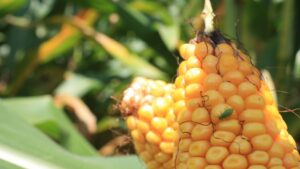A study by North Carolina State University (NC State) found that soil temperature can be utilized to monitor and anticipate the spread of corn earworm. This ability could help farmers manage the pest more effectively, therefore reducing the financial and environmental effects of pesticide use, according to a release.
Researchers used historical soil temperature data and long-term monitoring data and information that analyzed how the pest survives in cold conditions to gain a better grasp on how well corn earworm can last underground during colder winter months, or “overwintering success.”
The greater the overwintering success, the larger the areas where the pest can survive are, as corn earworm can migrate long distances, explain researchers. Greater overwintering in latitudes further north generally increase the possibility of crop damage due to the pest.
“There is a preconceived notion that pests have little overwintering success north of 40 degrees latitude,” said Douglas Lawton, former NC State postdoctoral researcher and co-corresponding author on an article describing the research. “That may have been true in the 1930s, but now we have more data-guided evidence to ask and answer the question, ‘Where can this species actually overwinter?'”
Researchers found that 40 degrees latitude is far from the best for overwintering success. The team devised their own maps as a result, overlaying the three varying data sets to display three relevant geographic zones: a “‘Southern Range’ where pests survive over the winter months, a ‘Northern Limits’ area where pests are generally unable to survive during winter months and a ‘Transitional Zone’ in between the northern and southern areas where pests may or may not survive over the winter,” explained the release.
The team examined the three zones to highlight historical trends for the pest and then employed a model to form predictions about the spread of corn earworm throughout the end of the century. Trends uncovered the Southern Range expanded by 3% since 1981, with the model suggesting the range will have doubled in size by the end of the century, shifting to the north. The other two zones are predicted to shrink.
“As the climate changes, the overwintering zones are likely to shift northward,” said Anders Huseth, co-corresponding author of the paper and assistant professor of entomology at NC State.
While the data showed Minnesota has seen no overwintering success of the pest from 1950 through 2021, the models show all of the state in the Transitional Zone.
“This is the canary in the coal mine for agricultural pests,” said Huseth. “Making sense of what’s taking place with this pest is really important for agricultural producers. We’ve shown here the element of uncertainty that can have demonstrable effects on farmers and potentially new opportunities for pesticide resistance selection. Our models visualize that change and provide touchstones for pest management.
“Now we’d like to come up with a better forecasting tool for this pest, along with a risk-prediction model, in order to give growers better information about pest spread. Success here could reduce both costs for farmers and pesticide into the environment.”
Read More:
New Corn Rootworm Biopesticide Receives EPA Registration
A Strong Defense Strategy is Crucial for Corn Growers to Manage Pests













